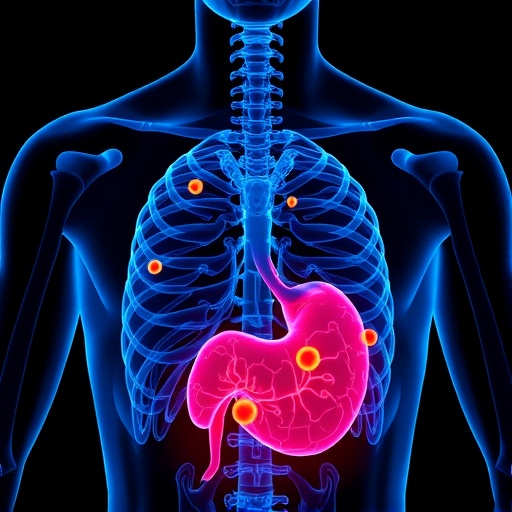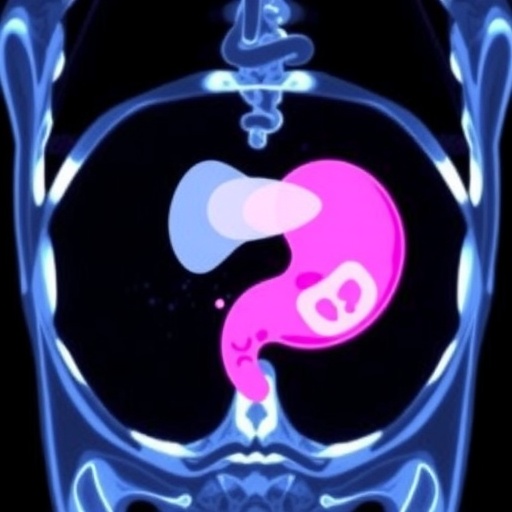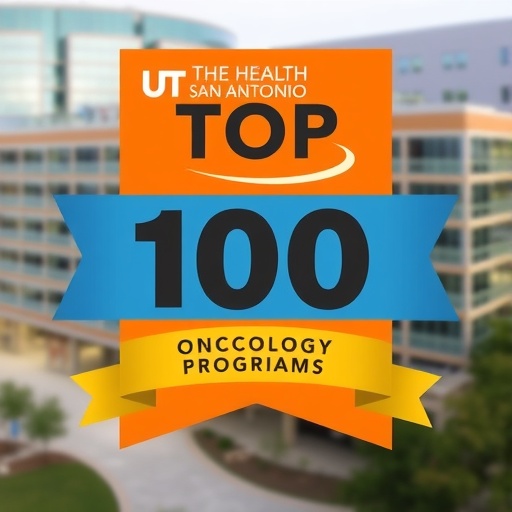In a groundbreaking advancement poised to reshape the therapeutic landscape of gastric cancer, researchers have unveiled compelling evidence demonstrating the potent antitumor efficacy of a novel combination therapy involving lapatinib and NNC 55-0396 dihydrochloride. This pioneering study, recently published in Medical Oncology, delves deep into the molecular and cellular interplay that underscores this drug duo’s capacity to impede the progression of gastric adenocarcinoma—a highly aggressive form of stomach cancer notorious for its poor prognosis and limited treatment options.
Gastric adenocarcinoma remains a formidable clinical challenge worldwide, ranking among the top causes of cancer-related mortality. Despite advancements in surgical techniques and chemotherapeutic regimens, the five-year survival rate for advanced stages stubbornly lags behind many other malignancies. This stark reality has galvanized scientific efforts to explore targeted therapies capable of improving patient outcomes. Against this backdrop, the investigation led by Gömeç, Yulak, and Ergül offers a beacon of hope, elucidating mechanisms by which lapatinib, a well-known tyrosine kinase inhibitor, synergizes with the calcium channel blocker NNC 55-0396 dihydrochloride, culminating in a robust anticancer response.
Lapatinib’s therapeutic relevance has long been established across several cancers due to its dual inhibitory action on epidermal growth factor receptor (EGFR) and human epidermal growth factor receptor 2 (HER2). Overexpression and dysregulation of these receptor tyrosine kinases frequently drive oncogenic processes including proliferation, angiogenesis, and resistance to apoptosis. The study meticulously confirms that lapatinib retains its capacity to selectively inhibit these signaling nodes in gastric cancer cells, thereby attenuating downstream pathways such as MAPK/ERK and PI3K/AKT, which are critical for cancer cell survival and invasiveness.
.adsslot_HG56bt3nCy{ width:728px !important; height:90px !important; }
@media (max-width:1199px) { .adsslot_HG56bt3nCy{ width:468px !important; height:60px !important; } }
@media (max-width:767px) { .adsslot_HG56bt3nCy{ width:320px !important; height:50px !important; } }
ADVERTISEMENT
Building on this, the incorporation of NNC 55-0396 dihydrochloride—a novel calcium channel antagonist blocking T-type calcium channels—introduces an unexpected yet potent dimension to this combinatorial approach. Calcium signaling intricately governs diverse cellular events ranging from gene expression to programmed cell death. Aberrant calcium flux has been implicated in the etiology and progression of multiple cancers, although its therapeutic targeting remains relatively nascent. The research team’s strategic use of NNC 55-0396 taps into this underexplored vulnerability, effectively dysregulating intracellular calcium homeostasis to induce cytotoxic stress specifically in gastric adenocarcinoma cells.
Beyond cellular models, in vivo investigations using xenograft mouse models of gastric adenocarcinoma provided crucial translational insights. Mice receiving the combination therapy exhibited marked tumor volume regression and extended survival times compared to monotherapy or control groups. Histopathological analyses of excised tumors revealed diminished proliferation indices and reduced angiogenic markers, underpinning the hypothesis that this drug pairing not only impairs cancer cell growth directly but also modulates the tumor microenvironment to stymie neovascularization—a key facilitator of tumor sustenance and metastasis.
Importantly, the study highlights a favorable toxicity profile for the combined regimen, with treated animals exhibiting minimal weight loss and no overt signs of systemic toxicity. This suggests a therapeutic window within which lapatinib and NNC 55-0396 can exert maximal anticancer effects while sparing normal tissues. Such findings bode well for potential clinical translation, where balancing efficacy and safety is paramount.
Molecular characterization undertaken through Western blotting and gene expression analyses shed light on the intricate crosstalk between EGFR/HER2 pathways and calcium-mediated signaling cascades. The blockade of tyrosine kinase activity appears to sensitize tumor cells to calcium dysregulation induced by NNC 55-0396, amplifying apoptotic signals. This synergistic interplay delineates a dual-hit mechanism capable of overcoming intrinsic resistance mechanisms that often thwart monotherapy regimens in gastric adenocarcinoma.
An intriguing aspect warranting further exploration involves the drug-induced modulation of the tumor microenvironment’s immunological landscape. Preliminary data hint at an immunomodulatory effect characterized by decreased infiltration of immunosuppressive cells and enhanced activation of cytotoxic T lymphocytes, potentially facilitating immune-mediated tumor clearance. The prospect of integrating immunotherapy with this combination regimen could herald a new era of multifaceted gastric cancer treatment paradigms.
The identified combination therapy also opens new avenues for biomarker-driven precision medicine. Given the heterogeneous nature of gastric adenocarcinoma, stratifying patients based on EGFR/HER2 expression and calcium channel profiles might refine candidate selection, thereby optimizing therapeutic outcomes. Such personalized approaches underscore a broader shift towards tailored interventions in oncology, leveraging detailed molecular insights to maximize efficacy.
While the findings are compelling, the authors prudently acknowledge limitations inherent to preclinical models and stress the necessity for rigorous clinical trials to validate safety, dosage parameters, and long-term efficacy in humans. Success in these arenas could revolutionize the management of gastric adenocarcinoma, potentially improving survival rates and quality of life for countless patients globally.
Moreover, the study exemplifies a broader methodological paradigm wherein repurposing existing drugs—such as lapatinib, already approved for breast cancer—and pairing them with emerging agents like NNC 55-0396 can accelerate developmental timelines and reduce costs. This strategy leverages known pharmacodynamics and toxicology, expediting clinical applicability without awaiting entirely novel drug discovery.
The scientific community eagerly anticipates follow-up studies that delve deeper into the mechanistic intricacies observed here, including the potential for combinatorial regimens with chemotherapeutics or immune checkpoint inhibitors. There is also substantial interest in exploring whether similar synergistic interactions could be harnessed in other malignancies characterized by EGFR/HER2 overexpression and calcium signaling dysregulation.
In summary, the investigation conducted by Gömeç, Yulak, and Ergül represents a milestone in gastric cancer research, unveiling a promising two-pronged therapeutic assault that integrates targeted tyrosine kinase inhibition with calcium channel blockade. Their work not only broadens the conceptual understanding of gastric adenocarcinoma biology but also delivers a tangible clinical strategy with the potential to save lives. As oncology continues to grapple with the complexity of tumor heterogeneity and resistance, such innovative approaches will undeniably be at the forefront of future cancer care.
Subject of Research: Antitumor activity of lapatinib and NNC 55-0396 dihydrochloride combination in gastric adenocarcinoma
Article Title: Investigation of the antitumor activity of lapatinib and NNC 55-0396 dihydrochloride combination in gastric adenocarcinoma
Article References:
Gömeç, M., Yulak, F. & Ergül, M. Investigation of the antitumor activity of lapatinib and NNC 55-0396 dihydrochloride combination in gastric adenocarcinoma. Med Oncol 42, 384 (2025). https://doi.org/10.1007/s12032-025-02942-8
Image Credits: AI Generated
Tags: antitumor efficacy of lapatinibcalcium channel blockers in oncologycancer-related mortality statisticsEGFR and HER2 inhibitorsgastric adenocarcinoma researchgastric cancer treatment advancementsimproving survival rates in gastric cancerinnovative therapies for advanced cancerlapatinib and NNC 55-0396 combination therapyMedical Oncology research findingsmolecular mechanisms in cancer therapytargeted therapies for stomach cancer





